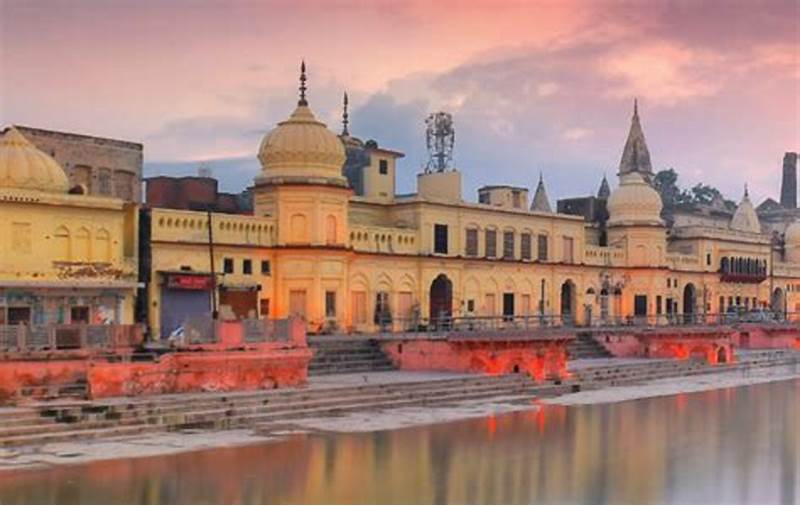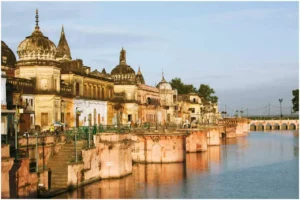Ayodhya is deeply rooted in Hindu spirituality and mythology, and it is frequently referred to as the place where Lord Rama was born. Settled along the banks of the sacrosanct Sarayu Stream in Uttar Pradesh, Ayodhya stands first among the seven most hallowed journey locales for Hindus. The Ramayana’s reference to Ayodhya as the capital of the ancient Kosala Kingdom is deeply entwined with the name itself. Ayodhya became synonymous with the epic tale of Lord Rama through the Ramayana. This ancient city is very important to millions of Hindus because it is a place where devotees worship Lord Rama and look for spiritual comfort.
Ayodhya Tourism –
The new Ram Temple, a massive structure that serves as a symbol of faith and devotion, can be found in the centre of Ayodhya. Numerous Hindus accept that it is situated at the site of Ram Janmabhoomi, the legendary origin of Rama, a central god of Hinduism. On 22 January 2024, amid extraordinary grandeur and festivity, the Ram Sanctuary was initiated, denoting a notable second for Hindu fans all over the planet. The temple complex became the third-largest Hindu temple in the world when it was finished. The temple’s presiding deity is Balak Ram or Rama in his infant form. It is an architectural masterpiece that attracts pilgrims seeking divine blessings.
If you are a first-time visitor to Varanasi and you are not aware about the local commute, you can book our one way cab to Varanasi. This will make your travel and your entire journey hassle-free and non-tiring.
Best Places To Visit in Ayodhya –
Ram Mandir
The very famous and the most controversial Ram Janmabhoomi is accepted to have been the origin of the Hindu divinity, Ruler Ram. Ram, Lord Vishnu’s seventh manifestation, is said to have been born along the Sarayu River in Ayodhya, according to the Indian epic Ramayan. The Ram Temple at Ram Janmabhoomi Ayodhya began construction in 2020 and was finished on January 22, 2024. Ram Janmabhoomi Ayodhya is still a place of great religious significance and pilgrimage for Hindus all over the world.
Hanumangarhi
Situated in Sai Nagar, Hanuman Garhi is a tenth-century sanctuary devoted to the Hindu God, Hanuman. It is customary to visit Hanuman Garhi before visiting the Ram Temple in Ayodhya, making it one of the most significant temples in the city. It is believed that Lord Hanuman resided at the Ayodhya-guarding temple site.
The Nageshwarnath Temple
The Nageshwarnath temple in Ayodhya was built in the name of the local deity, Lord Nageshwarnath. It is next to the Theri Bazaar in Ayodhya. It is accepted to have been set up by Kush or Kusha, Ruler Rama’s child.
Gulab Bari
Also known as the Garden of Roses, in Vaidehi Nagar, Ayodhya It is the burial chamber of the third Nawab of Faizabad (Oudh or Awadh), Nawab Shuja-ud-Daula and his folks.
The Gulab Bari, built in the 18th century, features fountains, lush greenery, a wide variety of rose varieties, and pure Nawab-style architecture.
Kanak Bhawan
The Kanak Bhawan is laid out towards the northeastern corner of the Smash Janmabhoomi in Tulsi Nagar. This temple, also known as Sone-ka-Ghar, was built in 1891. The Hindu deity Lord Rama and his wife, Goddess Sita, are honored at this sacred site.
Treta ke Thakur
Treta Ke Thakur, Ayodhya The Treta Ke Thakur Temple, which is located on the Naya Ghat of Ayodhya, is home to numerous idols, including those of Lord Ram, Sita, Lakshman, Hanuman, Bharat, and Sugreev. These sculptures are said to have been etched out of a solitary dark sandstone.
It is believed that Kullu, the king of the time, constructed Treta Ke Thakur 300 years ago.
Sita Ki Rasoi
Arranged on the north-western side of the Smash Janmanhoomi in Ayodhya’s Rajkot, Sita ki Rasoi is accepted to be an old kitchen utilized by goddess Sita herself. This sacred location, which was constructed quite close to the Ram Janmabhoomi, is now a temple that houses exhibit vessels. One among the two kitchens loved in Sita’s name, this Sita Ki Rasoi is a storm cellar kitchen.
Choti Chawani
The magnificent Choti Chawni, also known as Valmiki Bhawan or Maniramdas Chawni, is entirely constructed of white marble. This location is absolutely beautiful and well worth a visit.
Conclusion –
The Ayodhya Deepotsav, a grand festival celebrated with great fervour and enthusiasm, is one of the most anticipated events in Ayodhya. Begun in 2017, the celebration is praised around Diwali. Over 22.23 lakh diyas are lit up on Ram ki Paidi, breaking the Guinness World Record for the most diyas lit up in a single day during this festival. Also, read the related blog Things To Do In Varanasi – A Complete Travel Guide.




